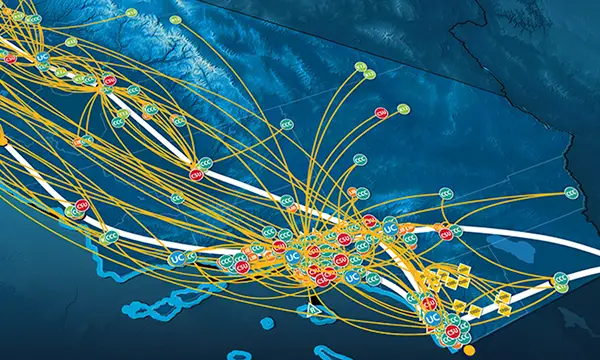- About
- Network
- Community
- Initiatives
- News
- Events
- Blog
- Publications

CENIC 2020 & 2021: Wrapping Up and Looking Ahead
Categories RENS & NRENS

As we look back on 2020, it was an unprecedented and busy year. Despite the uncertainty of the COVID-19 pandemic, CENIC staff successfully advanced our community’s strategic goals and continued to keep CENIC cost-effective, as it has been for over 20 years.
CENIC has in 2020: (1) met the exponential growth in traffic by investing in our networks; (2) helped connect California by reaching more un- and underserved sites, while continuously upgrading existing sites; and (3) sustained network performance and reliability with a secure CENIC and a resilient California Research and Education Network (CalREN). We will continue to pursue all of these goals in 2021.
Looking Back at CENIC in 2020
In 2020, CENIC advanced these milestone achievements:
- Assisted members with ad-hoc capacity upgrades, cloud connectivity, and bespoke connectivity solutions in support of their transition to online instruction and remote work.
- Extended CENIC’s services to new members such as more than 14 indigenous tribes in Southern California via the Pacific Wave International Exchange.
- Advanced upgrades to CENIC’s networks, including installation of 400G-plus capable hardware on CENIC’s coastal route, core node consolidation of hardware on the High-Performance Research (HPR) and Digital California (DC) networks, and the addition of route diversity from Sacramento to northern California and new nodes in Palo Cedro and Chico.
- Focused on automation and development to create network tools and application services to provide DDoS Managed Service (DMS), to streamline service outage handling with event collection thereby reducing to mean-time-to-repair and mean-time-to-resolution.
- Received $7.5 million from the state budget to pilot innovative approaches for provisioning broadband to the hardest-to-reach K-12 schools.
- Received a $4 million, five-year competitive grant from the National Science Foundation for continued operation and enhancement of Pacific Wave.

Looking Ahead at CENIC in 2021
In 2021, CENIC will continue its history of responsiveness and relevance to the diverse communities it serves, and will further advance its strategic goals to invest in the network, connect California, and ensure a secure CENIC and resilient CalREN.
Investing in the Network
CENIC plans to continue investing in the evolution of its network, including:
- Executing its five-year network roadmap. This involves network modernization, new service offerings, standardization, increasing network speed (such as extending CENIC's 400G-plus capabilities to the inland route, traversing Oakland, Sacramento, Fergus, Fresno, and Riverside), improving visibility, and a standardized design at all hub sites.
- Exploring new customer segments and automation technologies, including advancing CENIC's Infinity Project, a multi-year software development roadmap to modernize the systems architecture and create network tools and application services to facilitate workflow automation and network orchestration.
- Partnering with research and education networks and other commercial and cloud entities to share costs, facilities, and development.
- Deploying network transparency and measurement tools on CalREN networks and among CENIC institutions.
A Connected California
CENIC will continue to enhance connectivity among members, and continuing connecting institutions that are either unconnected or poorly connected. This work involves:
- Enhancing forecasting and deploying new circuits and/or new fiber connections for CENIC Charter Associate institutions.
- Partnering with urban and rural broadband working groups and private sector partners committed to innovations in urban and rural connectivity.
- Assisting the California Emerging Technology Fund (CETF) in achieving its goal of 98% broadband access in California, with CENIC’s focus on its community anchor institutions.
- Continuing to provide high-performance connectivity between 20+ campus Science DMZs that form the backbone of the NSF-funded Pacific Research Platform, now in its sixth year. Through CENIC, Pacific Wave hosts 550 GPUs, 7,000 CPUs, and 3.3 petabytes of Ceph storage, a distributed 10-campus cluster collectively called Nautilus at the heart of the NSF-funded CHASE-CI award, now in its fourth year. CENIC also connects Nautilus to other regional, national, and international networks, enabling collaborations that are increasing in reach and scope daily.
- Increasing the emphasis on “digital divide” in both rural and urban areas, focusing on home connectivity in the wake of the COVID-19 pandemic with our public and private sector partners, including working with policymakers at the state and federal levels to ensure that new funding for broadband connectivity is spent in ways that benefit anchor institutions and their constituents.
A Secure CENIC and a Resilient CalREN
To sustain network performance and reliability, CENIC is:
- Seeking visibility of all CENIC-operated equipment.
- Implementing strong authentication everywhere and continuing to implement security guidelines under the Mutually Agreed to Norms for Routing Security (MANRS).
- Developing robust internal networks.
- Increasing security personnel capacity.
- Advancing the ability to aid CENIC’s constituents with technical security mitigations.
- Updating its disaster recovery plan and conducting annual disaster preparedness and recovery drills.
As we reflect on how critical the network is to the 20 million Californians we serve, we will continue in 2021 and beyond to provide cost-effective, high-bandwidth networking to support the missions of our members. We will respond to the needs of our members’ faculties, staff, students, associated research groups, and customers. And, we will support excellence through collaboration and innovation with our scientific, education, healthcare, government, and private sector partners.
Related blog posts
The Big Game Is Big Data: How CENIC and the California Research and Education Network Support Member Athletics
When Fresno State needed to connect to Pac-12 Enterprises to broadcast a live football game over CBS, the Chancellor's Office reached out to CENIC for what Pac-12 later called the smoothest turn-up they've ever experienced.
Enabling Network-Based Collaboration Around the World: A Tour of CENIC and Partner Network Maps
On the Network Maps page at the CENIC website, you’ll find maps of all the networks, peering facilities, and exchanges to which CalREN connects, showing how thousands of CENIC member institutions connect to CalREN and to colleagues all over the globe.


